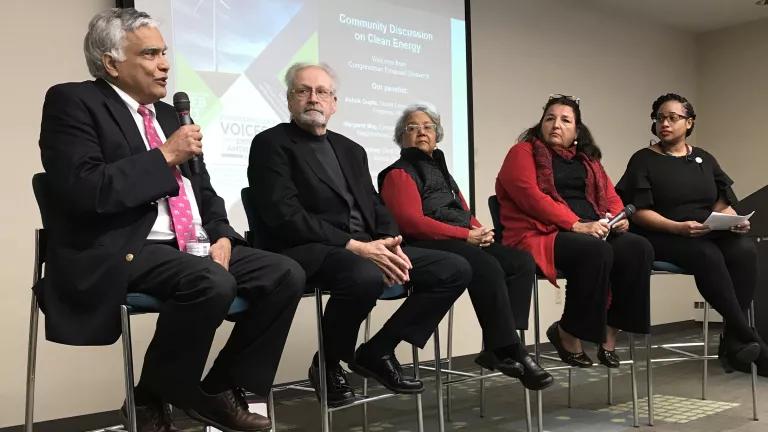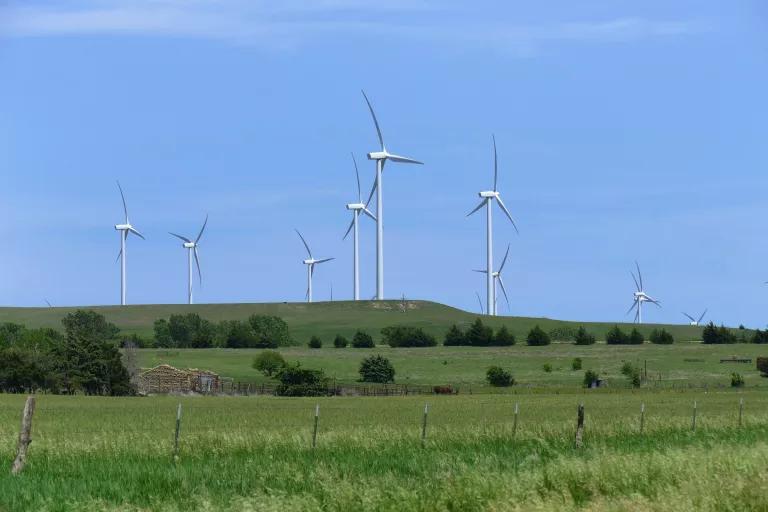A Catalyst for the Midwest’s Clean Energy Transition
Ashok Gupta spent decades cleaning up New York’s grid and reducing its reliance on dirty fuels. Now he’s working to bring the clean energy future to the Midwest.

When you discuss clean energy with senior energy economist Ashok Gupta, everything seems so obvious. Make it cheap; use it smartly. What’s all the fuss about?
Don’t let the simplicity of his vision fool you, though. Gupta understands the economics and politics of energy better than anyone working in the United States today. He has devoted his nearly 30-year career at NRDC to transforming the American power sector and to converting cities into clean energy laboratories. From 2004 to 2013, he served on New York City Mayor Michael Bloomberg’s Sustainability Advisory Board and Energy Policy Task Force, which created knowledge centers for carbon reduction and efficiency that served as models for other cities. In 2012, he moved to Kansas City, Missouri, and shifted his focus to the clean energy future of the Midwest, helping Missouri, Kansas, and their biggest cities to embrace efficiency and capitalize on the region’s dropping price of wind and solar power.
For all of this, and for mentoring and educating a generation of clean energy advocates, the American Council for an Energy-Efficient Economy (ACEEE) recently recognized Gupta as a champion of energy efficiency in buildings with a lifetime achievement award.
You’re working to replace coal-fired power plants with renewable energy in the deep red states of Kansas and Missouri. What’s your approach?
The short answer is money. If you can show stakeholders that renewables are cheaper than coal, they’ll make the transition. The trick is revealing how expensive coal really is. Coal managed to look cheap for decades, but only if you ignored its toll on public health, climate change, and other parts of our environment.
Over the last few decades, NRDC and other groups have worked to make the price of coal reflect its true cost. One tool is the Clean Air Act, which forces coal-fired power plants to install equipment aimed at reducing harmful air pollution. Gradually tightening those standards has both improved public health and helped integrate the hidden costs of coal into its price, as utilities are forced to clean up their emissions. Now, we’re finding ways to add the enormous costs of coal-fueled climate change into the equation. The work isn’t done—coal’s environmental damage is vast—but we’re getting there.

By most accounts, renewables are now a cheaper energy source than coal. So why does coal still account for 24 percent of U.S. electricity production, while wind and solar make up only 9 percent?
The changeover is happening, especially in the Midwest, but it’s piecemeal. Kansas went from zero percent wind power to 40 percent in 15 years, and all of that renewable energy displaced coal-fired power plants. If we do our job well, the state could get to 70 percent wind power in the next decade and zero carbon emissions by 2035. Our job is to accelerate the process using whatever levers we can pull.
Of course, we still have a long way to go, given the region’s historic reliance on coal. So we’re focused on policy tweaks that can make big changes. Here’s a nuts-and-bolts example. Consumers pay for the cost of building and upgrading power plants over the course of decades. So companies are reluctant to shut down their plants and risk losing whatever portion of the investment remains uncollected. We’re working with the utilities and state governments on a solution. In exchange for closing their dirty, coal-fired power plants, we’ll help the utility to refinance its investment at a lower rate and over a longer period of time. This frees up money for them to build wind or solar farms while simultaneously reducing the price of electricity for consumers. If the refinancing is done right, there is also money available to help local communities transition away from their reliance on coal-fired power plants.
What other transitions do you expect to see in the Midwest as it embraces the clean energy economy?
Cleaning up the power sector is part of a much larger picture. Our energy mix is complex right now. Our cars mostly run on gasoline. Our trucks mostly run on diesel. Our buildings heat their space and water with natural gas and oil.
As the grid becomes cleaner, we will want to transition our vehicles and buildings away from dirty fossil fuels too. We will have electric cars, electric HVAC, and electric hot water systems. We’ll have to find ways to reduce the stress on the grid so it can handle these new demands, beyond just switching over from coal to renewables.
So is that where efficiency comes in?
Yes. Here in the Midwest, we’re focused on greening the building sector. If we can improve building insulation, much of the electricity that used to go to air conditioning can instead power electric cars. Our Energy Efficiency for All initiative pays special attention to making sure the benefits of energy efficiency are available to low-income residents.
We are working with policymakers across the region to help push these efficiency policies forward. Many of our big cities, like Kansas City, now require large buildings to disclose energy and water usage. Collecting that data is the first step toward reform. St. Louis recently became the first Midwestern city to take the next step, requiring buildings to become more efficient. We’re not talking about new buildings—it’s a relatively lighter political lift to tighten standards on new construction. Instead, these standards will apply to existing buildings, which is huge progress toward reducing future emissions.

What are your long-term goals for the Midwest?
The utility serving the Kansas City area announced in August that it would reduce carbon emissions by 85 percent by 2030. And the St. Louis–area utility announced an 85 percent emissions reduction by 2040. The construction of new transmission lines will also pave the way for wind power produced in Kansas to cross the border. The utilities’ commitment will drive that process forward.
So much of our progress with cities is traceable back to NRDC. The New York City initiative that we partnered on as part of a task force led by Mayor Bloomberg helped us to develop a sustainability template that could be tailored to cities around the country. With the City Energy Project in 2012 and then through the American Cities Climate Challenge in 2018, NRDC secured funding to supply mayors of more than 25 city governments with the expertise and attention required to do that tailoring. The recent clean energy commitments across the Midwest are partly the fruits of that labor.
How does it feel to receive a lifetime achievement award for your work on clean energy and energy efficiency?
The best part for me was that ACEEE specifically recognized my work mentoring young advocates. People can’t do this work alone. It’s too big. That’s why I’ve always been focused on team-building, both inside of NRDC and with external partners. It was very touching to learn that people I mentored decades ago recommended that I be recognized for this honor.
I have a great job. I get to explain to policymakers that everyone wins under our plan. Cheaper electricity for consumers, a cleaner environment for our future, and a just transition for local communities.
This NRDC.org story is available for online republication by news media outlets or nonprofits under these conditions: The writer(s) must be credited with a byline; you must note prominently that the story was originally published by NRDC.org and link to the original; the story cannot be edited (beyond simple things such as grammar); you can’t resell the story in any form or grant republishing rights to other outlets; you can’t republish our material wholesale or automatically—you need to select stories individually; you can’t republish the photos or graphics on our site without specific permission; you should drop us a note to let us know when you’ve used one of our stories.
How to Ditch the Biggest Fossil Fuel Offenders in Your Life
A Consumer Guide to the Inflation Reduction Act
What Are the Solutions to Climate Change?